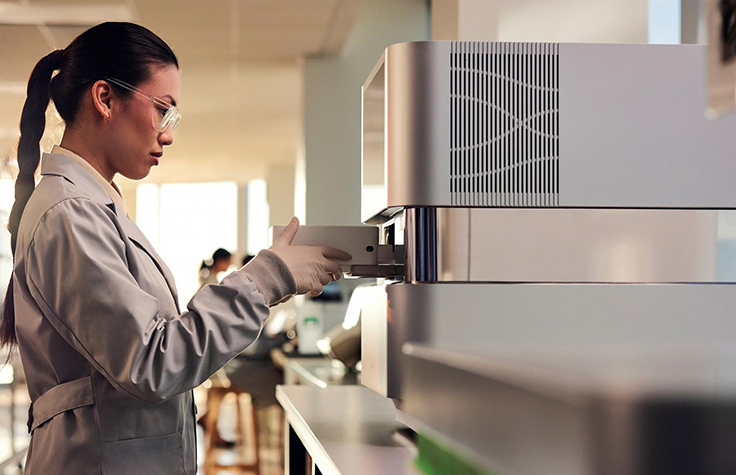A question to gurus of bacterial genome sequencing. I have a customer that wants to re-sequence 24 different bacterial genomes. What would be a reasonable level of multiplexing on MiSeq assuming an average genome size of 5-6 Mb and optimal (from your experience) for resequencing coverage depth? Would a combination with GS Jr sequencing improve the fidelity of assembly and ref mapping?
Seqanswers Leaderboard Ad
Collapse
Announcement
Collapse
No announcement yet.
X
-
Bear the following in mind however if you are performing a de novo on a miseq. Basespace/miseq reporter only samples 500Mb from each sample and tries to perform the assembly on this. If you have generated more than 500Mb for a sample you best bet is to assemble off line. The limit is due to the low processing power on the Miseq, de novos are pretty memory hungry.
We have done some re sequencing on the miseq and 25 sample is reasonable on a 2 x 250bp. If you upload you genome you will get coverage stats and some nice graphs. The only thing to be careful with is equal representation with 25 samples.
Comment
-
If you are going to suggest a second platform, PacBio is a far better choice than GS Jr. With an RS II instrument and a good library prep, 1-2 SMRT cells would probably be sufficient to assemble these genomes without the Illumina data.
The difference between 2x250 data and 454 Jr data isn't going to very great; only a small number of gaps will be patched by 454. In contrast, a good SMRT library is going to give you many 5Kb+ reads which are likely to span most repeats in a bacterial genome.
Cost-wise, I believe 454 Jr will be much more expensive than PacBio; many core facilities will make a library and run 2 SMRT cells for ~$1K. 1 SMRT cell would probably be sufficient if the data is to be combined with Illumina data (using PacBioToCA or similar pipeline).
Cost all four approaches out (Illumina only, PacBio only, Illumina+454 Jr, Illumina+PacBio), and keep in mind that the PacBio options have a much better shot of getting to 1 contig per DNA replicon.
Comment
-
If you want closed genomes de novo you could also just use the Illumina Nextera Mate-pair protocol. In our experience it works great and usually results in a single chromosome.
However, the mate-pair protocol is more expensive and time consuming compared to the normal nextera-PE protocols.
For coverage calculations you will need to know the average GC content of the genome in question. While 25x coverage might be OK for a 50% GC genome. It will be too little for a 65%+ GC genome.
rgds
Mads
Comment
Latest Articles
Collapse
-
by seqadmin
The field of epigenetics has traditionally concentrated more on DNA and how changes like methylation and phosphorylation of histones impact gene expression and regulation. However, our increased understanding of RNA modifications and their importance in cellular processes has led to a rise in epitranscriptomics research. “Epitranscriptomics brings together the concepts of epigenetics and gene expression,” explained Adrien Leger, PhD, Principal Research Scientist...-
Channel: Articles
04-22-2024, 07:01 AM -
-
by seqadmin
Proteins are often described as the workhorses of the cell, and identifying their sequences is key to understanding their role in biological processes and disease. Currently, the most common technique used to determine protein sequences is mass spectrometry. While still a valuable tool, mass spectrometry faces several limitations and requires a highly experienced scientist familiar with the equipment to operate it. Additionally, other proteomic methods, like affinity assays, are constrained...-
Channel: Articles
04-04-2024, 04:25 PM -
ad_right_rmr
Collapse
News
Collapse
| Topics | Statistics | Last Post | ||
|---|---|---|---|---|
|
Started by seqadmin, 04-25-2024, 11:49 AM
|
0 responses
19 views
0 likes
|
Last Post
by seqadmin
04-25-2024, 11:49 AM
|
||
|
Started by seqadmin, 04-24-2024, 08:47 AM
|
0 responses
19 views
0 likes
|
Last Post
by seqadmin
04-24-2024, 08:47 AM
|
||
|
Started by seqadmin, 04-11-2024, 12:08 PM
|
0 responses
62 views
0 likes
|
Last Post
by seqadmin
04-11-2024, 12:08 PM
|
||
|
Started by seqadmin, 04-10-2024, 10:19 PM
|
0 responses
60 views
0 likes
|
Last Post
by seqadmin
04-10-2024, 10:19 PM
|

Comment